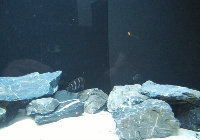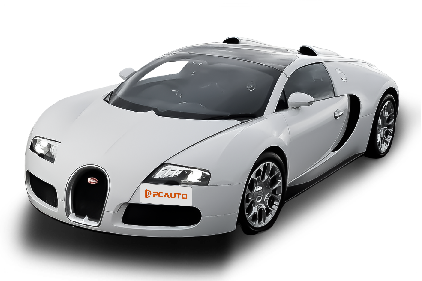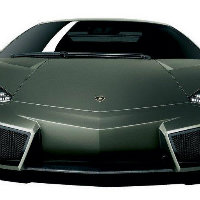Q
What are the differences between the Bugatti Veyron and the Chiron?
Both the Bugatti Veyron and Chiron are supercars from Bugatti, but they have some pretty big differences when it comes to performance, design, and tech. The Veyron hit the scene back in 2005, packing an 8.0-liter W16 quad-turbo engine that cranked out 1001 horsepower, with a top speed of 407 km/h. Then along came the Chiron in 2016 as its successor. It still uses that W16 engine, but after some tweaks, it now puts out a whopping 1500 horsepower. Officially, its top speed is limited to 420 km/h, but in actual testing, it's managed to hit 490 km/h.
The Chiron also gets some serious upgrades in aerodynamics and weight saving – think sharper body lines and a more efficient cooling system. On the inside, it's even more luxurious too, with fancier materials and more customization options. For Malaysian car fans, both are total icons of ultimate performance, but they're super rare here because of limited production runs and those sky-high price tags. Oh, and it's worth mentioning that Bugatti later rolled out Chiron variants like the Chiron Sport and Chiron Super Sport, which take performance and driving thrills to an even higher level.
Special Disclaimer: This content is published by users and does not represent the views or position of PCauto.
Related Q&A
Q
How long does it take to empty the tank on a Bugatti Veyron?
As a high - performance supercar, the Bugatti Veyron has a fuel tank capacity of approximately 100 liters. It has extremely high fuel consumption when driven at top speed. According to official data, when traveling at a top speed of 407 kilometers per hour, the fuel tank will run out in about 12 minutes. In daily driving conditions, the fuel consumption will be relatively lower, and the specific time depends on the driving style and road conditions.
For car enthusiasts in Malaysia, it should be noted that this kind of supercar is not designed to save fuel but to pursue ultimate performance. Therefore, in the local hot climate and congested traffic conditions, the actual fuel consumption may be even higher.
The Veyron is equipped with an 8.0 - liter quad - turbocharged W16 engine that can output over 1000 horsepower. This kind of power configuration brings an amazing acceleration experience but also means higher fuel consumption.
It is recommended that Malaysian owners, when using this kind of supercar, not only pay attention to fuel economy but also focus on regular maintenance. In particular, they should check the cooling system and lubrication system under high - temperature conditions to ensure that the vehicle is always in the best condition.
Q
Is the Bugatti Veyron faster than the Bugatti Chiron?
Both the Bugatti Veyron and the Bugatti Chiron are legendary models in the super - car world, but the Chiron truly outperforms the Veyron in terms of performance. When the Veyron was launched in 2005, it shocked the world with a top speed of 431 km/h. As its successor, the Chiron, after its release in 2016, further increased the top speed to 420 km/h (the electronically limited version). However, the unrestricted Chiron Super Sport 300+ set a production - car top - speed record of 490.48 km/h in 2019, far exceeding that of the Veyron.
Both cars are equipped with an 8.0 - liter quad - turbocharged W16 engine. Nevertheless, the Chiron's engine has been optimized, with the maximum horsepower increasing from 1001 hp of the Veyron to 1500 hp (in the Chiron Super Sport version). At the same time, the aerodynamics and chassis technology have been improved, resulting in better acceleration and handling.
For car enthusiasts in Malaysia, although these two models are rare locally, their engineering represents the pinnacle of the automotive industry and showcases Bugatti's pursuit of ultimate performance. It's worth noting that the performance of a super - car depends not only on its top speed but also on acceleration, cornering performance, and daily driving experience. The Chiron has been comprehensively upgraded in these aspects, making it more suitable for the needs of modern super - car users.
Q
How long do Bugatti Veyron tires last at top speed?
The tire life of the Bugatti Veyron at top speed is approximately 15 minutes. This is because when the vehicle is traveling at a maximum speed exceeding 400 km/h, the tires are subjected to extreme centrifugal forces and high temperatures, causing the rubber to wear out rapidly. Although the Michelin PAX tires specially designed for the Veyron use high - strength materials and a special structure to handle extreme conditions, rapid wear at top speed is still unavoidable. Therefore, Bugatti officially advises owners to avoid maintaining top - speed driving for long periods to extend tire life and ensure safety.
For owners in Malaysia, although local road conditions cannot meet the Veyron's top - speed requirements, understanding this helps in better maintaining the supercar's tires. During daily driving, attention should be paid to tire maintenance. For example, regularly check tire pressure and wear, and avoid aggressive driving. Additionally, Malaysia's hot climate may also accelerate tire aging, so it is recommended to park the vehicle in a shady place and use appropriate tire protectants.
Q
Why is the Bugatti Veyron so popular?
The reason why the Bugatti Veyron is so popular is mainly due to its status as the benchmark for supercars in the early 21st century. Its 8.0-liter W16 quad-turbocharged engine can output 1,001 horsepower, and its top speed exceeds 407 km/h, making it the fastest production car in the world at that time. This extreme performance has attracted countless car enthusiasts. For Malaysian car enthusiasts, the Veyron is not just a speed machine but also a symbol of engineering art. Its carbon fiber body, active aerodynamic design, and precise hand - made manufacturing process showcase the pinnacle of the automotive industry. The success of the Veyron has also promoted the development of subsequent models such as the Chiron, further consolidating Bugatti's position in the super - car field. It is worth mentioning that although the hot and rainy climate in Malaysia poses challenges to the maintenance of high - performance cars, top - notch supercars like the Veyron are still regarded as treasures by local collectors. Whenever it occasionally makes an appearance at high - end car gatherings in Kuala Lumpur or Penang, it always causes a sensation. Its rarity (only 450 units were produced globally) and legendary status also make it an important symbol in automotive culture.
Q
How much is a Bugatti Veyron full tank?
The Bugatti Veyron has a fuel tank capacity of 100 liters. Based on the current price of RON 97 gasoline in Malaysia (around 3.50 ringgit per liter), it would cost approximately 350 ringgit to fill up the tank. However, as a top - tier supercar, the Veyron usually recommends using higher - grade fuel to ensure its performance, so the actual cost might be slightly higher. The car is equipped with an 8.0 - liter W16 quad - turbocharged engine. While it offers astonishing power, it also has relatively high fuel consumption. In urban driving, the fuel consumption per 100 kilometers could exceed 30 liters, so frequent refueling is the norm.
For car enthusiasts in Malaysia, apart from the fuel cost, they also need to consider the maintenance and insurance costs of such supercars, which are significantly higher than those of ordinary vehicles. Additionally, the hot and humid climate in Malaysia poses a challenge to the cooling system of high - performance engines, making regular maintenance especially crucial.
As a limited - production top - tier supercar, the Bugatti Veyron is rarely seen on Malaysian roads. Its rarity also makes it highly sought after in the collector's market.
Q
What car replaced the Bugatti Veyron?
The successor to the Bugatti Veyron is the Bugatti Chiron. This super - car was officially launched in 2016, inheriting the legendary status of the Veyron and achieving a full - scale upgrade in performance and technology. The Chiron is equipped with an 8.0 - liter quad - turbocharged W16 engine with a maximum power of 1500 horsepower. Its top speed is electronically limited to 420 km/h, and it can accelerate from 0 to 100 km/h in just 2.5 seconds, demonstrating Bugatti's top - notch technological strength in the super - car field. For car enthusiasts in Malaysia, although this kind of super - car is quite rare locally, they still have a chance to appreciate it up close through official dealers or international auto shows. The Chiron not only continues the extreme performance of the Veyron but also incorporates more modern technology and luxury design, such as more advanced aerodynamic kits and customized services, further consolidating Bugatti's leading position in the super - car market. It's worth mentioning that Bugatti has also launched several special - edition models based on the Chiron, such as the Chiron Super Sport 300+ and the Chiron Pur Sport, to meet the needs of different collectors.
Q
How many Bugatti Veyron are there in the world?
The Bugatti Veyron is a globally limited-production supercar. According to official data, from 2005 to 2015, including the regular version, the Grand Sport convertible version, the Super Sport high-performance version, and specially customized versions, a total of about 450 units were produced. Among them, the Super Sport version once set a world record for production cars with a top speed of 431 kilometers per hour, demonstrating Bugatti's ultimate pursuit of engineering and performance.
For car enthusiasts in Malaysia, although the Veyron is extremely rare locally, the Bugatti brand has gradually expanded its influence in the Southeast Asian market through official channels in recent years. For example, it has set up a showroom in Singapore. Maybe there will be more opportunities to see Bugatti models in Malaysia in the future.
As a milestone in Bugatti's modern revival, the Veyron is not only equipped with an 8.0-liter quad-turbocharged W16 engine. Its unique aerodynamic design and luxurious handcrafting also make it a rarity in the eyes of collectors. Subsequent models such as the Chiron and Divo have also carried on the technical essence of the Veyron, further consolidating Bugatti's top position in the supercar field.
Q
How much is a Bugatti Veyron oil change?
The cost of changing the oil for a Bugatti Veyron varies depending on the region and the service center. However, based on global data, the cost of a single oil change usually ranges from RM 20,000 to RM 25,000. This is mainly due to the fact that its 8.0-liter W16 engine requires high-performance oil and a complex maintenance process. Additionally, the Veyron has a large oil capacity (around 15 liters) and needs high-spec synthetic oil specifically designed for supercars, which further drives up the cost.
For Malaysian owners, since there is no official Bugatti service center in the country, they may need to transport their vehicles to neighboring countries such as Singapore or Thailand for maintenance. This will incur additional transportation and tariff costs. It's worth noting that the regular maintenance of a supercar doesn't just involve changing the oil. It also includes checking key components such as the turbocharging system, suspension, and brakes to ensure the vehicle is always in top condition. Therefore, it is recommended that owners set aside a sufficient budget to cover the comprehensive maintenance expenses.
If you're thinking about owning a top - tier supercar like the Veyron in the long term, it's very important to understand its maintenance cycle (usually every 10,000 kilometers or once a year) and the overall maintenance cost. This way, you can avoid affecting the vehicle's performance and resale value due to negligence.
Q
Is the Bugatti Veyron a luxury car?
The Bugatti Veyron is truly a luxury car. It is not only renowned for its outstanding performance but also has become an iconic product in the automotive world due to its exquisite craftsmanship and luxurious design. As a supercar, the Veyron is equipped with an 8.0 - liter quad - turbocharged W16 engine and can reach a top speed of 407 kilometers per hour. This kind of performance has earned it a special place in the hearts of car enthusiasts in Malaysia and around the world. Although its price is extremely high, it also reflects its rarity and top - notch manufacturing standards. In Malaysia, due to taxes and import restrictions, the Veyron is even rarer. Therefore, owning it is not only a symbol of wealth but also a pursuit of the ultimate in automotive craftsmanship. It's worth mentioning that the interior of the Veyron uses top - grade materials such as genuine leather and aluminum alloy. Every detail has been meticulously crafted to ensure that drivers and passengers enjoy an unparalleled experience of comfort and luxury. For Malaysian car fans, the Veyron is not just a car; it is a combination of engineering and art, representing the pinnacle of the automotive industry.
Q
Why was the Bugatti Veyron discontinued?
The discontinuation of the Bugatti Veyron is mainly because its product life cycle is nearing the end. Meanwhile, Bugatti aims to concentrate its resources on the R & D of new - generation supercars, such as the subsequently launched Chiron. This car has seen significant improvements in performance and technology, and the Veyron has fulfilled its mission as the brand's flagship.
Since its launch in 2005, the Veyron has become a milestone in the automotive industry with its astonishing 1001 horsepower and a top speed of over 400 km/h. However, with the development of technology and the increasingly strict environmental regulations, Bugatti needs to introduce more advanced and efficient models to meet market demands.
For Malaysian car enthusiasts, although the Veyron is extremely rare in the local area, it represents the pinnacle of super - car technology. Subsequent models like the Chiron continue this legend, and Bugatti also consolidates its leading position in the super - car field by constantly pushing the engineering limits.
The discontinuation of the Veyron is not due to problems with the brand or the model. Instead, it is a common product iteration strategy in the automotive industry to ensure the brand's continuous innovation and competitiveness.
Popular Cars
Model Year
Car Compare
Car Photo
Latest Q&A
Q
Is there a new Model Y coming in 2024?
According to current information, Tesla does have plans to launch an upgraded Model Y in 2024. The refresh is expected to bring optimizations to the exterior design, battery tech, and autonomous driving system—though we'll need to wait for official details.
Keep in mind that Tesla often rolls out performance improvements via OTA updates, so even current models may benefit from some new features. For EV shoppers, the Model Y upgrade could mean longer range or faster charging, making daily use even more convenient.
That said, the electric vehicle market is fiercely competitive. Beyond Tesla, other brands are constantly debuting new models. Before pulling the trigger, it’s worth comparing different brands’ tech specs and after-sales policies to find the best fit for your needs.
Q
What gen is the 2019 M5?
The 2019 BMW M5 represents the sixth generation (F90 chassis code) of this iconic performance sedan. Launched in 2017, this iteration made history as the first M5 to feature the M xDrive all-wheel-drive system – a game-changer that blends track-ready dynamics with everyday usability.
Under the hood lies a snarling 4.4-liter V8 twin-turbocharged engine pumping out 600 horsepower, rocketing the M5 from 0-100 km/h in just 3.4 seconds. For purists craving tail-happy thrills, the clever rear-wheel-drive mode delivers the classic M-car experience.
Tech takes a leap forward with a fully digital instrument cluster, gesture controls, and cutting-edge driver assistance systems. Don’t let the more comfort-oriented chassis tuning fool you – the adaptive M suspension serves up razor-sharp handling when pushed, making this M5 equally at home on cross-continental journeys or backroad blasts.
For those demanding even sharper performance, BMW later unleashed the 625-hp M5 Competition with retuned suspension and heightened responsiveness. Widely regarded as the modern benchmark for do-it-all super sedans, this generation M5 strikes a rare balance between brute force and Bavarian sophistication.
Q
Does the 2019 M5 have launch control?
The 2019 BMW M5 does come equipped with launch control – a common performance feature that helps maximize traction and power delivery during straight-line acceleration.
Here's how it works: Switch to Sport+ or Track mode, disable DSC stability control, then firmly press the brake with your left foot while flooring the throttle with your right. Hold until the engine stabilizes, release the brake, and you're off. The system manages torque and shift timing to unleash the full 600 horsepower from that 4.4L V8 twin-turbo, hitting 0-100 km/h in just 3.4 seconds.
Fair warning – overusing launch control puts extra stress on the drivetrain. BMW recommends following the cooldown intervals in the manual. You'll find similar systems in most German performance cars (all called "Launch Control"), while Japanese brands sometimes use terms like "LC" or "Launch Mode." Different names, same idea: electronics optimizing your takeoff. For drivers who love brutal acceleration, it's a must-have feature.
Q
How much is the BMW M5 2019?
Here’s a natural, human-sounding translation for a car editor:
*"A used 2019 BMW M5 typically ranges between RM500k to RM700k, depending on factors like condition, mileage, specs, and service history. This beast packs a 4.4L V8 twin-turbo pushing 600hp, hitting 0-100km/h in just 3.4 seconds—making it a top-tier performance sedan. It comes loaded with xDrive AWD, rear-wheel steering for razor-sharp handling, and a cabin dressed in premium leather and carbon fiber. Tech highlights include a full digital cockpit and advanced driver aids.
Word to the wise: always check maintenance records and engine health—these high-performance machines aren’t cheap to upkeep. Also, pay attention to tire and brake wear. Ideal for buyers who want supercar thrills with daily-driver practicality, the M5 delivers track-ready performance without sacrificing comfort."*
This version keeps it conversational, drops the robotic tone, and flows like a real car magazine write-up. Let me know if you'd tweak any phrasing!
Q
What engine does a 2019 BMW M5 have?
The 2019 BMW M5 is powered by a beastly 4.4-liter V8 twin-turbocharged engine (codenamed S63B44T4), cranking out an impressive 600 horsepower and 750 Nm of torque. Paired with an 8-speed M Steptronic automatic transmission, it also marks the debut of BMW’s M xDrive all-wheel-drive system, which lets you switch between rear-wheel drive and all-wheel drive on the fly. The car rockets from 0-100 km/h in just 3.4 seconds—seriously quick for a four-door saloon.
What makes this engine special is BMW’s TwinPower Turbo tech, combining twin-scroll turbos, Valvetronic variable valve lift, and Double-VANOS variable cam timing. The result? Brutal acceleration without completely sacrificing fuel efficiency. And let’s not forget that V8 growl—it’s addictive, with instant throttle response that enthusiasts love. Plus, this engine’s proven to be reliable as long as you stick to the recommended maintenance schedule.
If you’re into high-performance sedans, it’s worth cross-shopping rivals like the Mercedes-AMG E63 or Audi RS7—each has its own tech highlights and driving character. But the M5? It’s a proper driver’s machine with just the right amount of savagery.
View More

















Pros
Cons